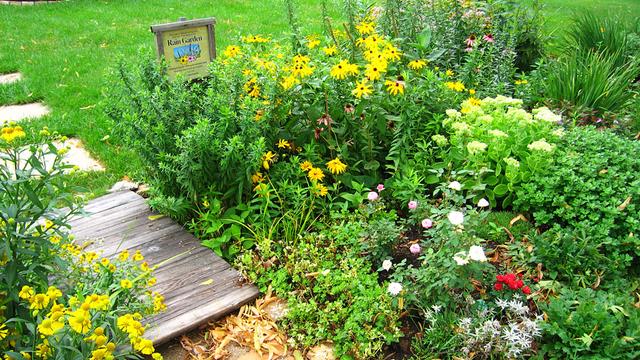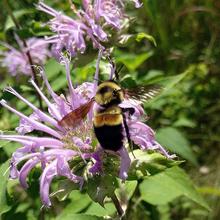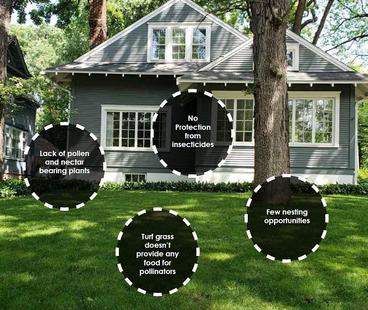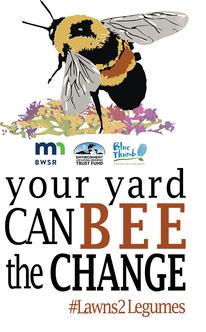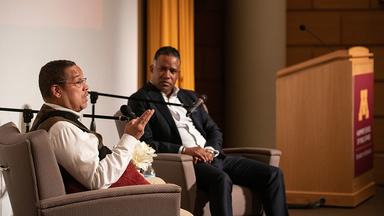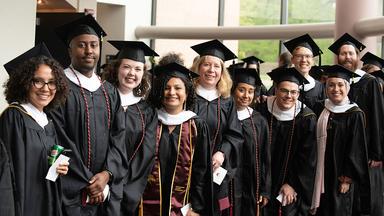On occasion, the Humphrey School of Public Affairs highlights stories of innovation from government offices around the state of Minnesota and the Native nations that share its geography. Here we highlight the Minnesota Board of Water and Soil Resources’ Lawns to Legumes pilot program — a first-of-its-kind, statewide initiative designed to assist Minnesotans in creating new pollinator habitat, and call residents into action to protect pollinators.
Pollinator species worldwide have been declining for decades, and organizations around the United States have committed to reestablishing pollinator habitat.
Here in Minnesota, the state's Board of Water and Soil Resources (BWSR) launched a pilot program called Lawns to Legumes to help protect 450 species of native bees, including the federally endangered rusty-patched bumble bee, and other pollinators from the effects of climate change, pesticides, and habitat disruption.
The program is partnering with more than a dozen organizations such as nonprofits, private businesses, state and local government agencies, and academic institutions to empower Minnesota residents to take action to protect pollinators in their own living spaces—such as transitioning from typical grass lawns toward yards with pollinator-friendly native plants, including legumes such as prairie clover and partridge pea.
Program partners want to bring residents of Minnesota into the work of protecting land and resources, and to make conservation accessible to individual contributors by focusing on equity and environmental justice.
Lawns to Legumes, so named by legislators who crafted the bill to fund the program, originated when Minnesotans concerned by the loss of pollinator species began asking state leaders and legislators how they could help.
The program received $900,000 in 2019 from the state’s Environment and Natural Resources Trust Fund to begin this work. Now, the program offers resources to support residential pollinator habitat across the state.
It holds workshops for homeowners on how to redesign their yards to be more conducive to pollinators such as bees, butterflies, moths, and beetles, with particular emphasis on the rusty-patched bumble bee. It also has extensive online resources including planting guides and recommended practices.
The program has provided funding to applicants from around the state to help pay for installing native plantings, and created “demonstration neighborhoods” in collaboration with local government and nonprofit organizations to provide examples of landscape redesigns. These resources are intended to provide access to those who want to protect pollinators and convince others to do the same.
Breaking away from the norm
The traditional grass lawn has a long history in the U.S.
“People are very dedicated to their lawns. It’s a social norm,” said Becky Rice, executive director of Metro Blooms, a key Lawns to Legumes partner. “Seeing other options of landscaping is important in convincing change.”
The traditional lawn requires significant amounts of water to maintain, and local officials around the state want to discourage residents from using too much water on their grass. Lawns and landscaping also require fertilizers and pesticides that can disrupt pollinator habitats that do exist.
Local governments and nonprofits have received grants from the program to install demonstration neighborhoods in a dozen locations around the state. These demonstration projects are enhancing pollinator habitat in those areas, raising awareness about residential pollinator protection, and offering an alternative landscape design.
“We want this to be a movement. [Residents] can have a really big impact on protecting pollinator species and other wildlife,” said Dan Shaw, senior ecologist and vegetation specialist with BWSR.
Lawns to Legumes also gave grants up to $350 to help residents establish pollinator habitats in their individual yards; some grants went to applicants just to plant a single tree or a few native shrubs.
During its first year, the program received more than 7,500 grant applications, demonstrating the need for additional funding for residential pollinator programs.
Outreach and equity
Lawns to Legumes is a statewide initiative, which means it engages with Minnesotans from rural and urban areas alike, and from all backgrounds and income levels. So it aims to include an environmental justice lens in its approach—working with renters, who often have little say or stake in the landscape of their home; low-income communities that may not have access to training or resources to invest in landscape redesign; and communities of color, whose concerns about air and water pollution, and food accessibility, often go unheard.
Since its start, Lawns to Legumes has prioritized equity considerations by seeking insight and contributions from communities already working in environmental justice — North Minneapolis, Brooklyn Park, the Fond du Lac Reservation. It uses those local relationships to promote buy-in from residents in those communities.
Equity is also a factor in the selection process for individual support grants. BWSR developed a spatially based lottery system that gives extra consideration to applicants who live in areas of concern regarding environmental justice. Lawns to Legumes continues to explore new ways to ensure that low-income, minority, and tribal communities are represented among grant recipients.
The Minneapolis College of Art and Design (MCAD) was an essential partner for a year-long social media campaign that raised awareness about the program. MCAD student illustrators created original artwork depicting Minnesota pollinators and native plants, which were used during the campaign to educate the public about the importance of pollinator habitat. Fifty students at the institution took courses that focused on copy writing and advanced illustration to create language and design options for this campaign.
“We prepare young creatives to speak the language of business, so they can better advocate for their creative solutions,” said Stephen Rueff, professor and chair of the Arts Entrepreneurship Department.
Including students in the work is another element of the Lawns to Legumes’ goal of encouraging involvement and contributions from throughout Minnesota's communities.
A community movement
According to Becky Rice with Metro Blooms, if residents across the state set aside a small fraction — around 5 percent — of their available landscape to native pollinator-friendly plants, it would be enough to support the wellness of local pollinators. But it’ll take more than solitary acts by individual residents; some bee species don’t travel very far, only around 300 feet, according to Dan Shaw. So bees need several points of available landscape in close proximity to one another. It needs to be a community effort.
The Carlton County Soil and Water Conservation District (SWCD), the Xerces Society, and the Fond du Lac Reservation partnered with the Oldenburg Arts and Cultural Community to establish a community focus on pollinator species. They’ve held native pollinator plant sales, and will host two events in August — a Bee Friendly Kids Camp and a Honey Bee Festival — to encourage buy-in from county residents and create a culture that prioritizes environmental protection.
“We want the pilot program to help people do this themselves,” said Alyssa Bloss, conservation specialist with the Carlton SWCD.
The Lawns to Legumes program is applying for more funding to resume making grants for demonstration neighborhoods and individuals. In the meantime, the program continues to spread the word about the importance of pollinator-friendly habitats, alongside its community partner organizations across the state, through ongoing outreach activities and educational resources.
The hope is that protecting pollinators will remain a top priority in Minnesota’s environmental policy for years to come and with that, Minnesotans will take ownership of this work.
Find resources and updates on the Lawns to Legumes website.
Program partners:
- Blue Thumb
- Metro Blooms
- Minnesota Association of Soil and Water Conservation Districts
- Minnesota Association of Watershed Districts
- Minnesota Department of Natural Resources
- Minnesota Interagency Pollinator Protection Team
- Minnesota Master Gardeners Program
- Minnesota Water Stewards
- Minnesota Zoo
- Monarch Joint Venture
- Pollinate MN
- Pollinator Friendly Alliance
- University of Minnesota Bee Lab
- Wild Ones
